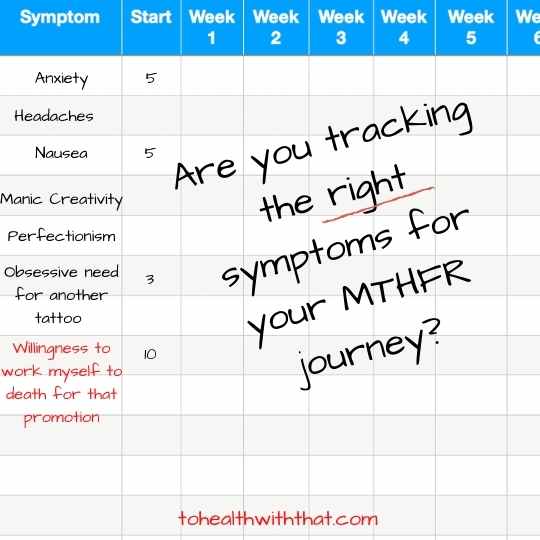I know everyone wants me to say “Buy the first 5-LMTHF product you see and gobble it down,” but I just can’t do that to you because after you tried it, you would hate me forever. And with good reason – jumping into 5-LMTHF before you’re ready to do so can create a kind of nightmare scenario for your body in which you’ve suddenly got a resource that has been in short supply, but none of the supportive structures around that resource. So toxins are dumping left and right but can’t actually be eliminated, neurotransmitters are bobbing up and down like pole vaulters, and mood, energy, and sleep are desperately trying to keep up. In short, starting that way isn’t pretty.
The only real correlation I can make with the MTHFR journey is the process of pregnancy. You can try to rush it, but it’s going to work out badly 9 times out of 10. You’ve just got to go at the pace of the project and not get ahead of yourself.
This requires laying a good foundation even though that seems like the boring part. Believe me, in this case, we WANT to prevent fireworks. So this week, let’s talk about doing the prep-work at the very baby beginning of the MTHFR journey. This will require 3 things.
- A symptom tracker
- One heck of a pantry overhaul and some carbo-loading
- A talk with the family, significant others, and maybe your pet hamster.
A symptom tracker is key here, even if you aren’t a total data geek like I am. The goal is to establish your baseline symptoms this week before you’ve made any big changes and while you’re finishing all of the folic-acid enriched food in your pantry.

For many of us MTHFR folks, folic acid enriched food and supplements contribute to the symptom picture and even just the act of taking those out of your diet (which will be next week’s project) will have a noticeable impact on your symptoms. At this point you want to get a feel for what symptoms might be caused by folic acid because that will make things so much easier down the road. Your future self will thank you.
So let’s do a quick rundown of how to use a symptom tracker. That is something you can start today. First off, there is a free symptom tracker available for download at tohealthwiththat.com – just sign up for the email list and it’s yours along with a couple of other MTHFR-related freebies. There are also loads of symptom tracking apps if you prefer the technological method.
Make a list of all of the symptoms you notice on a daily basis, things like brain fog or fatigue, or whatever it is that is your normal. Also, the ones that show up every now and then, like maybe headaches or menstrual cramps. It doesn’t matter if you think they’re related to MTHFR or not, just add them to the list. Every day, rate each symptom on a scale from 0 – 10. If you’re not experiencing that symptom, it’s a zero. If it’s the worst it could possibly be, it’s a 10. What you’re trying to figure out is your “normal” state.
The goal is to be able to tell when you’re progressing or when a change has been worth it, and when it really hasn’t. Also, when adding something might be causing problems because that is really common for us. Responses to different supplements are incredibly varied with MTHFR and so it is important to keep track of what works for you because there isn’t any one-size-fits all.
What we want this week is to get a clear picture of where you are right now. This is because next week we’re going to make a BIG change. Next week, we’ll take all of the synthetic folic acid out of your diet and supplements.
Taking synthetic folic acid out of your life has to happen with MTHFR. There is really only one study done in this area, but it’s hugely compelling and essentially indicates that taking folic acid for people with the MTHFR mutation (or taking too much folic acid for everyone else) actually hinders the pathway it is supposed to help. So instead of converting into the active form of folate, which is 5-LMTHF, folic acid blocks up the conversion process and gets in the way of an already compromised enzyme pathway. The bottom line is that with an MTHFR polymorphism, taking folic acid will make your symptoms, and your functional folate deficiency, worse.

This week, to prepare for that pretty major step, I want you to enjoy your bread and pasta. Wheat products are the most commonly fortified foods globally, and they’ve been fortified with folic acid as a public health measure to prevent birth defects. In that regard, it’s a highly successful program, it just isn’t the best program for MTHFR folks. I do want to say, however, that if it is a choice between no folate at all and synthetic folic acid, then the synthetic folic acid wins. Some folate is better than none in a starvation situation even if it’s the worst possible form. Assuming that nobody listening to this podcast or reaading the blog post is in a starvation situation, it’s best to avoid folic acid as completely as possible.
If you want to learn more about this, go back to S1E9, This Vitamin Could Be Hurting You podcast episode, or the show notes including research, here.
When you’re shopping for next week, if you want bread it’s going to have to be either gluten-free, which doesn’t have wheat and is therefore generally not fortified, or organic whole wheat, which is also typically not fortified, but check your labels. If it says folic acid or folate anywhere on the label, then it has aded folic acid and you should exclude it.
In good news, the gluten free and organic options have come a long way and there are many more of them. In bad news, the US recently extended their fortification program to include corn products as well, so check all of your labels including those on things like corn chips and tortillas. Also, double check the regulations in your own country. In most places, wheat is the most commonly fortified food, but there could be others as well.
It is truly important to get the folic acid out of your diet as completely as possible because for many people, it’s actually causing symptoms. This could include depression, anxiety, inflammatory conditions like pain or overarching issues like fatigue or insomnia.
Also, check your vitamins, supplements, energy bars, meal replacement powders, energy drinks, birth control pills, and prescriptions. If your doctor has given you a prescription that includes folic acid it is important to talk with them before making any changes and find an alternative that will work better for you. Especially if you are on an antifolate agent such as methotrexate.
Remember, you’re not actually starting the folic acid elimination this week – you’re just doing the prep work. Clear out the pantry, finish your bread and pasta so it isn’t wasted, check your vitamins, supplements, and prescriptions and talk with any practitioners or doctors to make sure everything is smooth and ready for the transition. I don’t know if anybody remembers the movie Office Space, but what we’re doing here is Planning to Plan.
If you’re looking for a free resource about foods commonly fortified with folic acid, there is one in the MTHFR Library in Genetic Rockstars, our MTHFR community. It also has some ideas for MTHFR-safe substitutions.
The third thing that is probably a good idea this week, is talking to the people close to you. This is a process and you may need some support through it. You may also need to tell people why your favorite brunch place is off the menu for a while, because avoiding wheat products is super strange at first and culturally it’s a big committment. We make everything out of wheat, so this is the hardest change you’ll have to make on this entire journey.
I’m glad I warmed this season up with the hardest thing I’ll be asking you to do. That is great marketing on my part. If any of you stay with me, next week we’ll actually start taking the folic acid out of your life. After that, I should have eliminated my audience completely. Thank you so much for listening and I really hope you stick around for all of this.

MTHFR is a common genetic mutation that can contribute to anxiety, depression, fatigue, chronic pain, infertility, and more serious conditions like breast implant illness, heart attack, stroke, chronic fatigue syndrome, and some types of cancer. If you know or suspect you have an MTHFR variant, schedule a free 15-minute meet-and-greet appointment with MTHFR expert Dr. Amy today.
Book Your Appointment
